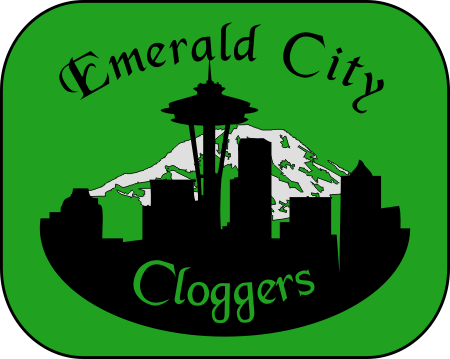Some of the questions asked of cloggers are...
What is clog dancing?
Why is it called clogging?
Do cloggers wear wooden shoes?
Is clogging a form of tap dancing?
Clogging is a North American folk dance that originated in the
Appalachian Mountains. It's an art form and very much a part of our heritage! Irish,
Scottish, English, Dutch, and
Germans who settled there in the mid 1700s all played a role
in this great form of dance. Tap, jazz, and
hip-hop styles of dance have had and continue to play a big role in the
evolution of clogging. As each new generation of clogger uses their
current style of music and dance, they further evolve this amazing form of
dance.
The word "clog" means "time" in Gaelic. Clogging is danced keeping time with the downbeat of the music. Because of the clogging name, many
people assume we dance in wooden shoes but this is a misconception! The reality is most cloggers wear taps
and shoes which look similar to tap shoes.
The difference between clogging shoes and tap shoes is mainly in the
style of tap. Tap shoes have a single tap attached to the toe and heel. Most clogging taps
have an additional tap riveted on top of the single tap. These are
called "double taps" or "bell taps" and make more of a "jingle" sound.
Although clogging and tap
dancing look similar, they do have their differences. Cloggers keep time
to the down beat of the music and their style of taps emanate a
different sound. Although various cloggers may wear different dance shoe
types or dance in a somewhat different form, they all keep time to the
music with their feet.
People clog throughout the United States and Canada. It has also
gained great popularity throughout the world! While most cloggers dance
for leisure, there are individuals who form teams and compete in area,
state, and national events.
There are many variations to the standard clogging style.
Mainstream clogging is done on the flat and
ball portions of the feet with heel clicks, toe snaps, drags, and slides with
the foot movement. The more advanced buck style form of clogging is danced on the
balls and heals of the feet while adding more intricate and faster steps. Canadian and flat-footing
clogging steps are often utilized in the more advanced styles of clogging as well.
Irish Step Dancing differs greatly from other clogging forms and is often confused with the
American form of clogging. Instead of
the feet being side by side they are placed one in front of the other,
toes turned out as in 5th position (ballet). The body is kept in a more
uniform upright position and unique foot and ankle movements add to the
beauty of this style.
